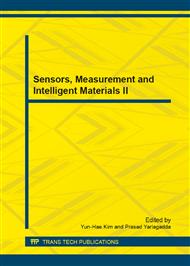[1]
Sharma & Uma, Optimization of parameters for adsorption of methylene blue on a low-cost activated carbon. J. Chem. Eng. Data. 55 (2010), 435-439.
DOI: 10.1021/je900408s
Google Scholar
[2]
Yanhui Li, Qiuju Du, Tonghao Liu, Jiankun Sun, Yonghao Wang, Shaolin Wu, Zonghua Wang, Yanzhi Xia, Linhua Xia. Methylene blue adsorption on grapheme oxide / calcium alginate composites. Carbohyd. Polym. 95 (2013), 501-507.
DOI: 10.1016/j.carbpol.2013.01.094
Google Scholar
[3]
D. Kobayashi, C. Honma, A. Suzuki, T. Takahashi, H. Matsumoto, C. Kuroda, K. Otake, A. Shono. Comparison of ultrasonic degradation rates constants of methylene blue at 22. 8 kHz, 127kHz, and 490kHz. Ultrason. Sonochem. 19 (2012), 745-749.
DOI: 10.1016/j.ultsonch.2012.01.004
Google Scholar
[4]
W. J. Huang, Z. W. Li, Y. J. Lin, C. H. Yang, Y. J. Liou. Electro-catalytic characterization and dye degradation of Ti1−x(Bi)xO2 in acidic solution. Ceram. Int. 38 (2012), 4631-4634.
DOI: 10.1016/j.ceramint.2012.02.043
Google Scholar
[5]
P. Li, G. Zhao, K. Zhao, J. Gao, T. Wu. An efficient and energy saving approach to photocatalytic degradation of opaque high-chroma methylene blue wastewater by electrocatalytic pre-oxidation. Dyes Pigments. 92 (2012), 923-928.
DOI: 10.1016/j.dyepig.2011.06.009
Google Scholar
[6]
F. Zhao, L. Liu, F. Yang, N. Ren. E-Fenton degradation of MB during filtration with Gr/PPy modified membrane cathode. Chem. Eng. J. Available online 5 July 2013. http: /dx. doi. org/10. 1016/j. cej. 2013. 06. 117.
DOI: 10.1016/j.cej.2013.06.117
Google Scholar
[7]
T. Liu, Y. Li, Q. Du, J. Sun, Y. Jiao, G. Yang, Z. Wang. Adsorption of methylene blue from aqueous solution by graphene. Colloid. Surface. B. 90 (2012), 197-203.
DOI: 10.1016/j.colsurfb.2011.10.019
Google Scholar
[8]
Y. -S. Ho, W. -T. Chiu, C. -C. Wang. Regression analysis for the sorption isotherms of basic dyes on sugarcane dust. Bioresour. Technol. 96 (2005), 1285-1291.
DOI: 10.1016/j.biortech.2004.10.021
Google Scholar
[9]
H. L. Liu, X. F. Sun, C. Q. Yin, C. Hu. Removal of phosphate by mesoporous ZrO2. J. Hazard. Mater. 151 (2008), 616-622.
Google Scholar
[10]
A. Wael, Y. Nao-Daniel, W. Martin, S. Witkowski, J. R. Strub. Influence of preparation and wall thickness on the resistance to fracture of zirconia implant abutments. Clin. Implant Dent. R. 14 (2012), 196 -203.
DOI: 10.1111/j.1708-8208.2011.00428.x
Google Scholar
[11]
M. N. Aboushelib, J. P. Matinlinna. Combined novel bonding method of resin to zirconia ceramic in dentistry: A pilot study. Adhes J. Sci. Technol. 25 (2011), 1049-1060.
DOI: 10.1163/016942410x534993
Google Scholar
[12]
M. Das, C. Dhand, G. Sumana. Electrophoretic Fabrication of Chitosan-Zirconium-Oxide, Nanobiocomposite Platform for Nucleic Acid Detection. Biomacromolecules. 12 (2011), 540-547.
DOI: 10.1021/bm1013074
Google Scholar
[13]
Y. H. Yun, V. T. Turitto, K. P. Daigle. Initial hemocompatibility studies of titanium and zirconium alloys: prekallikrein activation, fibrinogen adsorption, and their correlation with surface electrochemical properties. J. Biomed. Mater. Res. 32 (1996).
DOI: 10.1002/(sici)1097-4636(199609)32:1<77::aid-jbm9>3.0.co;2-m
Google Scholar
[14]
F. Ferrero. Adsorption of methylene blue on magnesium silicate: kinetics, equilibria and comparison with other adsorbents. J. Environ. Sci. 23 (2010), 467-473.
DOI: 10.1016/s1001-0742(09)60131-5
Google Scholar
[15]
A. A. Farghali, M. Bahgat, W. M. A. El. Rouby, M. H. Khedr. Decoration of MWCNTs with CoFe2O4 nanoparticles for methylene blue dye adsorption. J. Solution Chem. 41 (2012), 2209-2225.
DOI: 10.1007/s10953-012-9934-0
Google Scholar
[16]
Aksu Z., Donmez G. A. Comparative study on the biosorption characteristics of some yeast for remazol blue reactive dye. Chemosphere, 50 (2003), 1075-1083.
DOI: 10.1016/s0045-6535(02)00623-9
Google Scholar
[17]
J. Ma, L. L. Yu, L. Jin, Z. W. Yuan, J. H Chen. Adsorption of methylene blue on the modified as-prepared carbon nanotubes. Environ. Chem. 31 (2012), 646-652.
Google Scholar
[18]
E. Rubín, P. Rodríguez, R. Herrero, de E. S. Vicente. Adsorption of methylene blue on chemically modified algal biomass: equilibrium, dynamic, and surface data. J. Chem. Eng. Data. 55 (2010), 5707-5714.
DOI: 10.1021/je100666v
Google Scholar
[19]
I. Langmuir. The adsorption of gases on plane surfaces of glass, mica and platinum. J. Am. Chem. Soc. 40 (1918), 1361-1403.
DOI: 10.1021/ja02242a004
Google Scholar
[20]
H. Freundlich. Over the adsorption in solution. J. Phys. Chem. 57 (1906), 385-470.
Google Scholar
[21]
F. Haghseresht, G. Lu. Adsorption characteristics of phenolic compounds onto coal-reject-derived adsorbents. Energ. Fuel. 12 (1998), 1100-1107.
DOI: 10.1021/ef9801165
Google Scholar
[22]
H. Tel, Y. Altas, M. Eral, S. Sert, B. Cetinkaya, S. Inan. Preparation of ZrO2 and ZrO2-TiO2 microspheres by the sol-gel method and an experimental design approach to their strontium adsorption behaviours. Chem. Eng. J. 161 (2010), 151-160.
DOI: 10.1016/j.cej.2010.04.053
Google Scholar
[23]
A. Bentouami, M. S. Quali. Cadmium removal from aqueous solutions by hydroxyl-8 quinoleine intercalated bentonite. J. Colloid Interface Sci. 293 (2006), 270-277.
DOI: 10.1016/j.jcis.2005.06.040
Google Scholar
[24]
S. S. Mohd, H. C. Chin, Z. Sarani, M. J. Saad, K. A. Mohd, L. C. Kah, K. Poi Sim, S. C. Wee. Citric acid modified kenaf core fibres for removal of methylene blue from aqueous solution. Bioresour. Technol. 102 (2011), 7237-7243.
DOI: 10.1016/j.biortech.2011.05.011
Google Scholar


